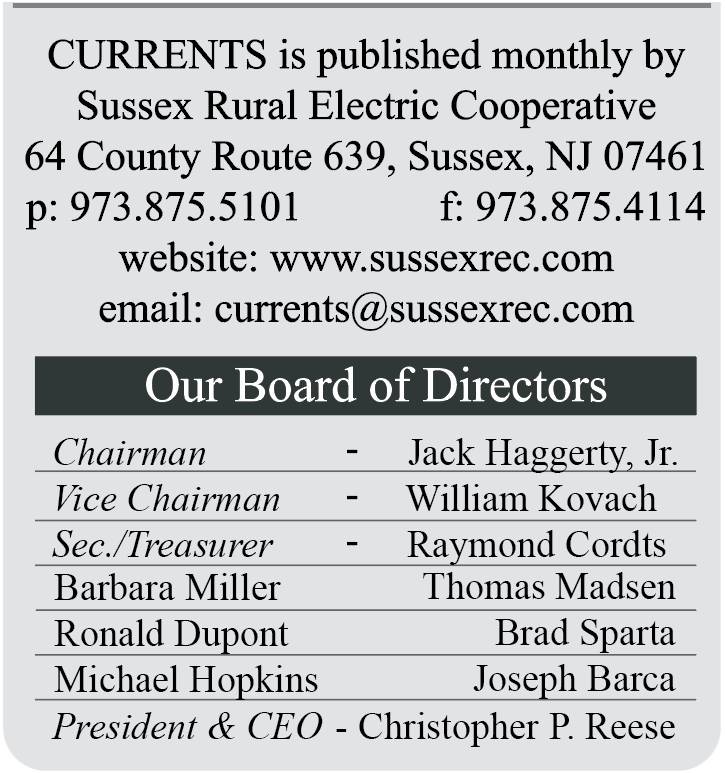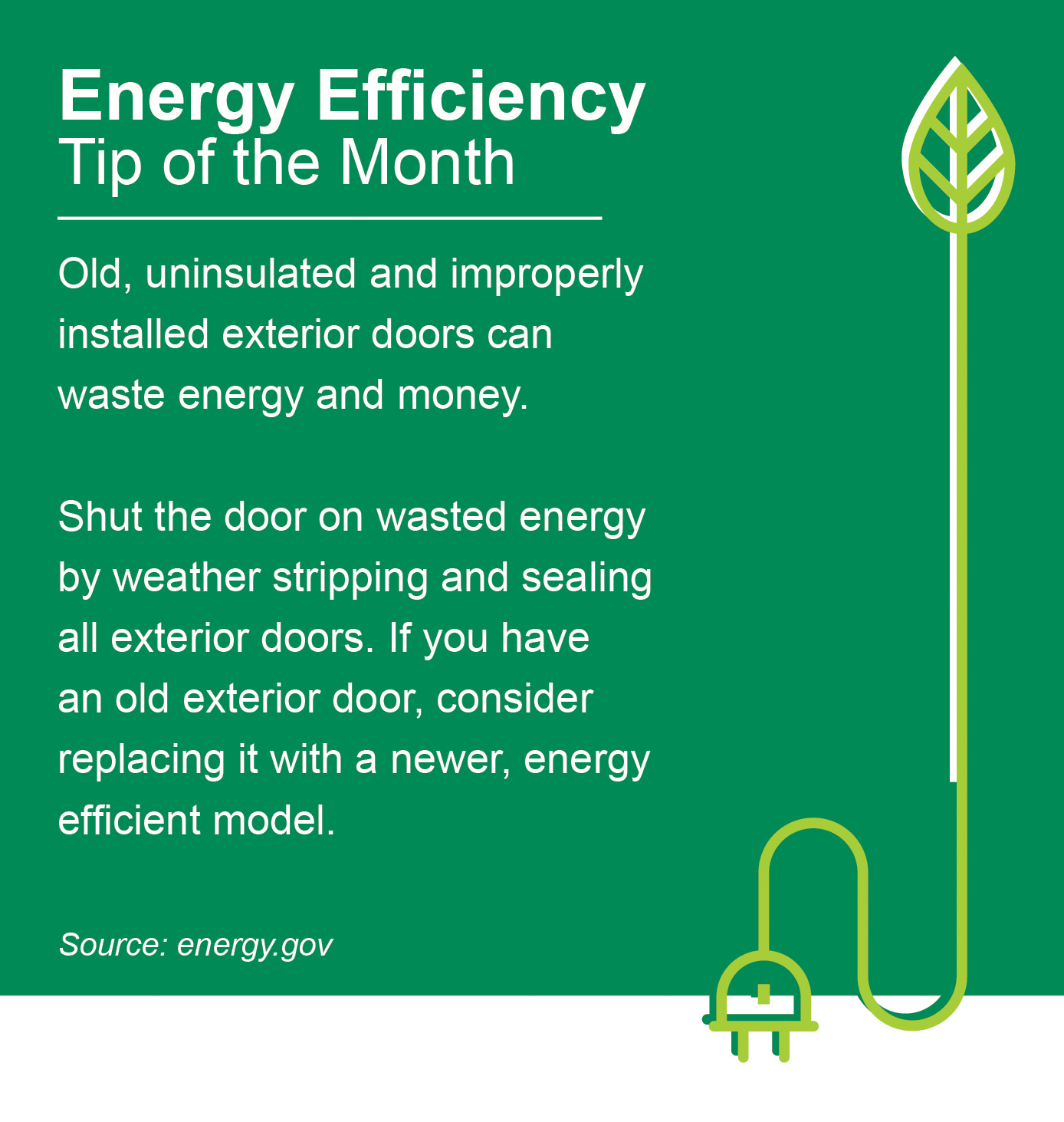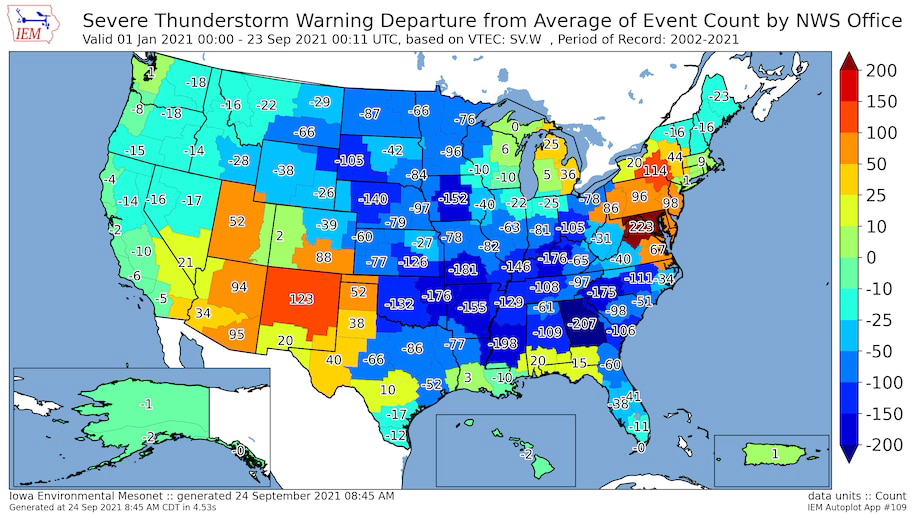To view the full print/pdf version of this issue of Currents, click here
For previous issues of Currents, visit our Currents Library
The Causes of Outages
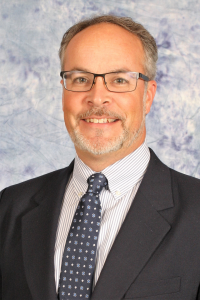
By: Chris Reese, President & CEO
Email: contacttheceo@sussexrec.com
Working at Sussex Rural Electric Cooperative means working to fulfill a commitment to our members. Lately, we have received some feedback from members who are concerned about the frequency of recent outages in some locations. It is true that over the last few months outages have been a little more frequent in certain areas, like Glenwood and Lafayette. While our line crews, engineers, and operations staff work hard to ensure that power is restored quickly and efficiently, we all understand the frustration.
Ultimately, most recent outages have been a result of two interrelated factors: extreme weather and trees. Living in a heavily wooded area like ours means trees are both a blessing and a curse. While they contribute greatly to the idyllic, natural landscape that we all enjoy, they are also a large contributor to power outages. In fact, trees and their branches are the #1 cause of power blinks and outages in our service territory. Trees that have been weakened by powerful storms are more easily knocked down and risk making contact with or fully toppling overhead power lines. This is something we work hard to mitigate, but some things, like the weather, are beyond our control.
We have been affected by two separate tropical cyclones during the last few months, Tropical Storm Elsa and the remnants of Hurricane Ida. These both posed significant challenges. This is not helped by the fact that, in general, weather patterns have become more erratic. Some organizations like the Environmental Protection Agency have speculated that weather is becoming more extreme due to a shifting climate. We’ve included here a map from the Iowa Environmental Mesonet tracking severe thunderstorm warnings departure from normal in 2021. You can see that our area has received 98 more warnings than in a normal year. I’m not taking a side on the climate change topic – but I do know we have certainly been affected by stronger and somewhat more frequent weather events.
In some cases, a strong storm only affects a small area. A good example of this is a Lake Panorama member’s video from July, found at sussexrec.com/panorama-storm. That could just as easily look like a coastal storm, not one in Vernon, NJ. The storm was very powerful in this area even while other pockets of our service territory saw nothing out of the ordinary. Due to the linear nature of power distribution, one part of our service territory can lose power because of system damage in another area “upstream” that is bearing the brunt of a storm.
Storm damage to trees has been an issue for a long time, and one that SREC has made significant investments to mitigate. The Co-op has the ability to trim tree limbs or branches in our right of way, the area within a certain distance around our power lines. We use this to limit tree contacts on our lines.
 Tree-trimming is the Co-op’s largest yearly expense. For years, we have employed the services of Asplundh Tree Experts, LLC to trim the entirety of our service territory’s 700+ miles of lines on a four-year cycle. In addition, they are responsible for trimming branches or removing trees that are marked as a hazard following SREC’s supervisor or even member reports. As mentioned in my Q&A segment in our Online Meeting (which you can check out at sussexrec.com/online-meeting), we have been analyzing the growing cycles of local trees and are looking at the possibility of speeding up our trimming cycles in higher growth or higher tree density areas, going from four years to three years.
Tree-trimming is the Co-op’s largest yearly expense. For years, we have employed the services of Asplundh Tree Experts, LLC to trim the entirety of our service territory’s 700+ miles of lines on a four-year cycle. In addition, they are responsible for trimming branches or removing trees that are marked as a hazard following SREC’s supervisor or even member reports. As mentioned in my Q&A segment in our Online Meeting (which you can check out at sussexrec.com/online-meeting), we have been analyzing the growing cycles of local trees and are looking at the possibility of speeding up our trimming cycles in higher growth or higher tree density areas, going from four years to three years.
While we do all we can to mitigate the impact of tree damage by maintaining our right of way, I must be candid that this cannot completely fix the problem. Some of the trees that have caused recent outages have fallen from well outside of our rights of way, on the opposite side of the road from our lines. Storm damage, compacted with age of many tall trees in our area and damage from invasive pests like the emerald ash borer, can cause trees to fall onto our power lines from 40 feet or more outside of our rights of way. This was the case for a recent outage on Wednesday, September 8th that affected hundreds of members around Clark Road in Wantage, when strong winds caused a tree to fall and pull down a 3-phase main line.
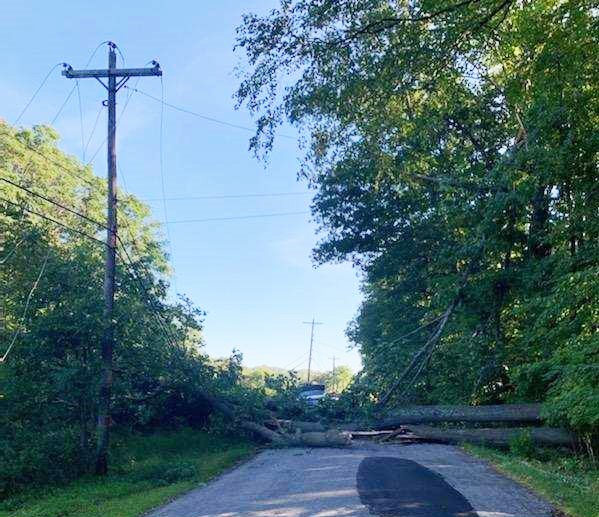 Later that month on Sunday the 19th, despite fair weather, two large oak trees on Pond School Road in Wantage fell from the opposite side of the road onto our power lines, breaking a pole and bringing down five spans of 3-phase wire (pictured here). This caused a power outage for about 155 members in Wantage and into Lafayette and created a safety hazard. A car drove right into the fallen trees across the road while our crews had just arrived and were assessing the situation. Thankfully no one was hurt. This shows that trees create a risk to both the flow of power and to driver safety.
Later that month on Sunday the 19th, despite fair weather, two large oak trees on Pond School Road in Wantage fell from the opposite side of the road onto our power lines, breaking a pole and bringing down five spans of 3-phase wire (pictured here). This caused a power outage for about 155 members in Wantage and into Lafayette and created a safety hazard. A car drove right into the fallen trees across the road while our crews had just arrived and were assessing the situation. Thankfully no one was hurt. This shows that trees create a risk to both the flow of power and to driver safety.
As with weather patterns, we have no control over trees outside of our rights of way. Unfortunately, this means that heavily wooded areas, like parts of Sussex and Wantage or our various lake communities in Vernon, have seen an increase in outages. While not all outages are preventable, our members can take comfort in how we respond to these events. Of the two outages mentioned above, the September 8th outage was resolved in 97 minutes and the September 19th outage was resolved within a few hours, which I think is reasonable considering the need to clean up the large trees, install a new pole, and deal with the aftermath of the vehicle collision.
Members ask from time to time why we don’t switch to underground power lines as a solution to the tree problem. Aside from the very high price to do that and the time investment that would go to making this switch, underground lines sometimes can prolong outages due to both the time it takes to identify a fault when you cannot see the wire and to excavate before making repairs. That being said, we evaluate each situation and location independently, and underground replacement is considered if it makes sense.
With some outages, we can take advantage of the ability to redirect power to certain spots of our service territory. This is where we can switch power or “backfeed” from another line or circuit via remote controls that we can operate from our office control system. While this cannot be used in all situations, when it can it helps affected members get power back to their homes sooner while we work on the damage that caused the original outage.
All in all, we remain committed to our mission: providing the highest quality of service at the lowest possible cost. While some circumstances are beyond our control, we will always continue to do everything in our power to keep your power flowing. And if a tree falls in the woods and knocks down our power lines, we will hear it. You can always count on SREC crews to resolve the issue.
